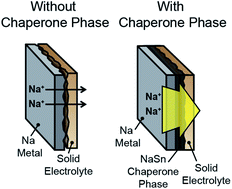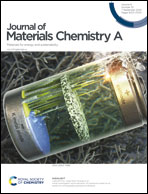Tin-based ionic chaperone phases to improve low temperature molten sodium–NaSICON interfaces†
Abstract
High temperature operation of molten sodium batteries impacts cost, reliability, and lifetime, and has limited the widespread adoption of these grid-scale energy storage technologies. Poor charge transfer and high interfacial resistance between molten sodium and solid-state electrolytes, however, prevents the operation of molten sodium batteries at low temperatures. Here, in situ formation of tin-based chaperone phases on solid state NaSICON ion conductor surfaces is shown in this work to greatly improve charge transfer and lower interfacial resistance in sodium symmetric cells operated at 110 °C at current densities up to an aggressive 50 mA cm−2. It is shown that static wetting testing, as measured by the contact angle of molten sodium on NaSICON, does not accurately predict battery performance due to the dynamic formation of a chaperone NaSn phase during cycling. This work demonstrates the promise of sodium intermetallic-forming coatings for the advancement of low temperature molten sodium batteries by improved mating of sodium–NaSICON surfaces and reduced interfacial resistance.



 Please wait while we load your content...
Please wait while we load your content...